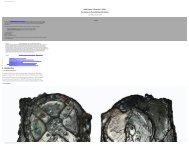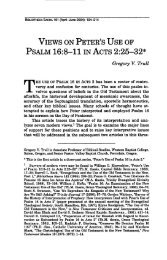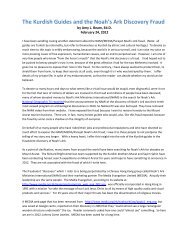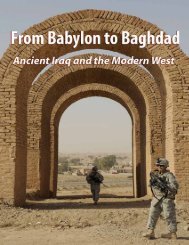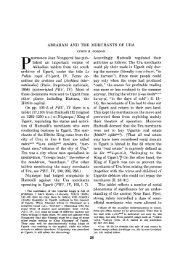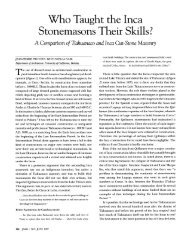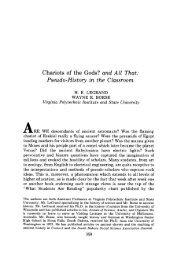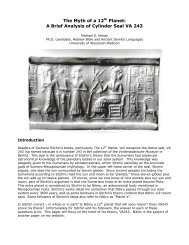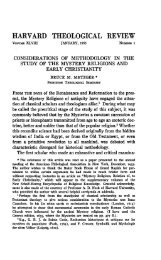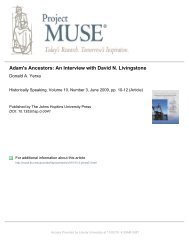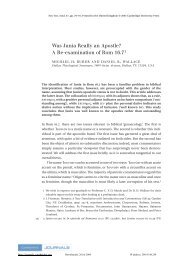"ACCORDING TO THE LAWS OF MOSES" - Michael S. Heiser
"ACCORDING TO THE LAWS OF MOSES" - Michael S. Heiser
"ACCORDING TO THE LAWS OF MOSES" - Michael S. Heiser
You also want an ePaper? Increase the reach of your titles
YUMPU automatically turns print PDFs into web optimized ePapers that Google loves.
"<strong>ACCORDING</strong> <strong>TO</strong> <strong>THE</strong> <strong>LAWS</strong> <strong>OF</strong> MOSES"<br />
JACOB MILGROM<br />
When the scroll of the Torah is raised during the synagogue service, the congregation<br />
recites the words, Vezot haTorah asher sam Moshe lifne bene Yisroel<br />
dpi Adonai beyad Moshe [This is Torah that Moses set before the Israelites by<br />
the command of the Lord through Moses] (a paraphrase of Deuteronomy 4:44<br />
and Numbers 4:37). Is it possible to affirm the Mosaic origin of the text of the<br />
entire Torah, not as blind faith but with conviction, rationally, critically?<br />
Anyone who reads the law codes of the Torah carefully will realize that they<br />
are rife with apparent inconsistencies and contradictions. I cite one example:<br />
The tithe is prescribed in three major codes. The recipient, however, differs in<br />
all three. In Leviticus 27:30, the recipient is the sanctuary; in Numbers 18:26,<br />
the Lévites; in Deuteronomy 26:12, 12:17, 14:26, the fanner. Moreover, the<br />
crops subject to the tithes also differ. Numbers and Deuteronomy legislate that<br />
they are the grain, the wine from grapes, and the olive; but Leviticus rules that<br />
all crops are subject to the tithe, as well as animals. The rabbis, being Jurists not<br />
exegetes, harmonize the differences: the Numbers text is maintained - the tithe<br />
is given to the Lévites. On the other hand, the rabbis ruled that the texts in Leviticus<br />
and Deuteronomy refer to a second tithe entirely.<br />
How, then, are we to believe that these are laws promulgated by Moses, if we<br />
need the rabbis to gloss over contradictions and inconsistencies?<br />
There is an aggada, a rabbinic story, that Moses asked God for permission to<br />
visit Akiba's academy on earth. Permission was granted. Moses sat in the back<br />
and listened to Akiba expound a law presumably based on the Torah. Moses did<br />
not understand a word - tasas koho [his energy was drained]. At the end of the<br />
lesson, the students challenged Akiba, "M'nayin lakh [What is your source?]."<br />
Jacob Milgrom, Professor Emeritus of Biblical Studies at the University of California at Berkeley,<br />
is the author of seven books and over 250 articles, and has been chosen as a fellow of six honorary<br />
societies. He is a recipient of four honorary degrees, and has received awards from the Biblical<br />
Archaeology Society and the National Foundation of Jewish Culture.
4 JACOB MILGROM<br />
Akiba replied, "Halakha leMoshe miSinai [(It is) an oral law from Moses at Sinai]."<br />
The end of the story relates that "the mind of Moses was put at ease<br />
[nityasseba dato]" (T. Menakhot 29b).<br />
Two obvious deductions can be derived from this story. First, between the<br />
time of Moses and Akiba, the laws of the Torah had undergone vast changes,<br />
reflecting problems faced by Akiba's generation. Second, Moses was pacified<br />
when he realized that Akiba was not creating a "new" Torah, but had traced his<br />
teaching back to the revelation at Sinai.<br />
David Weiss Halivni offers a systematized perspective on Divine revelation in<br />
rabbinic literature. There are two positions: "minimalist" and "maximalist."<br />
Halivni refers to the story of Moses and Akiba as the minimalist position, that<br />
God revealed to Moses general principles of the codes of the laws, from which<br />
each successive generation would derive its relative applications. Thus, while<br />
Moses formulated these laws in the Torah, he did not author Akiba's decisions,<br />
though he might have intended them, and, had he lived in Akiba's generation,<br />
concurred with his conclusions.<br />
The maximalist position "dogmatically asserts that the entire written and oral<br />
Torah [including] whatever novelum an earnest scholar [talmid vatik] will<br />
someday teach has already been declared to Moses at Sinai" (P. Pe'ah 17a). I<br />
recall a quintessential maximalist announcing on radio that for Jewish law the<br />
word "history" has no meaning. For him, time, as it were, stood still since Sinai,<br />
when both the written law and the entire compendium of the oral law were<br />
given. Anything else, in his view, should be thrown out of court.<br />
That subsequent generations attributed their legal decisions to Moses is actually<br />
confirmed in Scripture, however. For example, II Chronicles 30:16 relates<br />
that: [The priests and the Lévites] took their accustomed stations according to<br />
the laws of Moses, the man of God [ketorat Moshe ish-Elohim]. But, no such<br />
stations are attributed to the priests and Lévites in the Torah! Nevertheless, the<br />
priests and Lévites did have their stations in the Tabernacle, albeit different<br />
ones. This suffices for the Chronicler to declare that the clerical stations in his<br />
own time were of Mosaic origin.<br />
A more impressive example, perhaps, is Nehemiah's amana (Neh. 10:Iff.); the<br />
covenant agreement subscribed to by Israel's leaders and accepted on oath by the<br />
people to follow the Teaching of God, given through Moses the servant of God<br />
JEWISH BIBLE QUARTERLY
"<strong>ACCORDING</strong> <strong>TO</strong> <strong>THE</strong> <strong>LAWS</strong> <strong>OF</strong> MOSES" 5<br />
[b'yad Moshe eved Elohim] (v. 30). None of the 10 or 18 laws in the legal roster<br />
of the amana was prescribed precisely this way in the Torah. Nonetheless, each<br />
law can be derived from a pentateuchal source. Nehemiah evidently understood<br />
that ihe Teaching of God was formulated by Moses His servant when he formulated<br />
the amana laws on Mosaic foundations.<br />
The question, however, still remains: What were the Mosaic principles underlying<br />
the formulation of legal traditions in the Torah? It could well be that they<br />
derive from the Decalogue (or possibly some equivalent formulation that never<br />
made it into the canon). The Decalogue, however, is but a terse core. Without<br />
penalties, it reads more like guiding principles than laws. No wonder that later<br />
traditions, based on the Torah text but by different authors and in different times,<br />
might in fact differ from one another in form and content.<br />
In this regard, Halivni cites an ancillary minimalist position:<br />
Rabbi Yannai said: The words of the Torah were not given as<br />
clear-cut decisions .... When Moses asked, 'Master of the universe,<br />
in what way shall we know the true sense of the law?' God<br />
replied, 'The majority is to be followed, [a play on the words in Ex.<br />
23.2] - when the majority declares it is impure, it is impure; when<br />
the majority says it is pure, it is pure.' (Midrash Tehillim 12.4; cf B.<br />
Hag. 3b).'<br />
As Halivni perceptively concludes:<br />
Contradictions are thus built into revelation. Revelation was formulated<br />
within the framework of contradiction in the form of argumentation<br />
pro and con. No legitimate argument or solution can be in<br />
conflict with the divine opinion, for all such arguments and solutions<br />
constitute a part of God's opinion.<br />
Revelation is not a one-time Sinaitic event. Thus, it behooves us humans - indeed,<br />
compels us - to be an active partner of God in determining and implementing<br />
the Divine Will.<br />
The ostensible contradictions among the tithe laws, I suggest, represent an<br />
example of the Halivni's principle of "contradictions built into revelation," and<br />
the argumentation that went into the rabbis' reconciliation of the biblical contradictions<br />
are traceable back to the same Sinaitic source (halakha I'Moshe miSinai).<br />
Talmudic legal formulations may properly presume Sinaitic precedents<br />
Vol. 32, No. 1,2004
6 JACOB MILGROM<br />
(Moses in Akiba's academy). Conflicting laws, as well, may each be justifiable<br />
claimants to Sinaitic origin (Moses in Yannai's midrash). All in a sense are according<br />
to the laws of Moses.<br />
A few more words concerning the remaining phrase of the pledge to the Torah,<br />
by the command of the Lord through Moses; or, in the Torah's own words, the<br />
Lord spoke to Moses. That God spoke to Moses is not difficult to accept on rational<br />
grounds. Major scientific discoveries are often not the result of logical<br />
deductions. Some are by chance, like Hertz's discovery of wireless waves, or<br />
Fleming's of penicillius notatum. Others originate in what scientists call flashes<br />
of intuition. In religion, we call these flashes of intuition the revelations of the<br />
moral God.<br />
Let us then acknowledge that all the principles, traditions, and formulations<br />
that are represented in the composition of the Torah and continue to enrich<br />
"global Torah" have a valid claim to the conviction that its laws are traceable to<br />
Mosaic origins. As for their divergences, we might adopt the words coined by a<br />
later generation of rabbis concerning the differences in the schools of Hillel and<br />
Shammai: "Both are the words of the living God [eluv'elu divre Elohim hayyim]<br />
(T. Gittin 6b). The result? I am able to recite the words zot haTorah asher sam<br />
Moshe in total faith and conviction.<br />
NOTES<br />
' "On Man's Role in Revelation," From Ancient Israel to Modern Judaism, Vol. 11, [Fest.<br />
M.V.FoxJ, ed. J.Neusner, et al. (Atlanta: Scholars Press, 1989) p. 30.<br />
2. The legal language is apt: In America, federal and state statutes are theoretically derived from the<br />
Constitution. The Supreme Court is the ultimate authority interpreting the letter and spirit of the<br />
Constitution, but the nine members of the Court in any given period of time may be minimalists or<br />
maximalists, answering the question, "If the writers of the Constitution were living in the present<br />
time, how would they have judged?" This process is analogous to Halivni's concept of the development<br />
of the oral law in Judaic jurisprudence.<br />
3. See also T. Baba Metzia S9b: During a controversy about what is the halakha in a certain case, a<br />
bat kol from heaven intervened. Cried Rabbi Joshua, NTl ü'ntua N"? (playing on Iieuteronomy<br />
30.12) - that is to say, it is not for heaven to determine halakhot, but men.<br />
JEWISH BIBLE QUARTERLY



